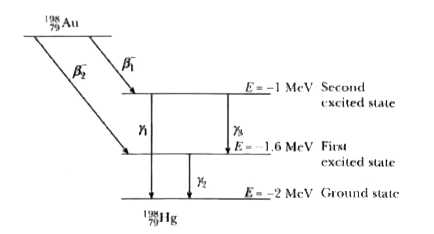.12N beta decays to an ecited state of .12C, which subsequenctly decays to the ground state with the emission of a 4.43−MeV gamma ray. What is the maxium kinetic energy of the emitted beta particle?
To determine the Q value for this decay, we first need to find the mass of the product nucleus .12C in its excited state. In the ground state, .12C has a mass of 12.000000u, so its mass in the excited state is
12.000000u+4.43MeV931.5MeV/u=12.004756u
In this decay, a proton is converted to a neutron, so it must be an example of position decay. The Q value is, accoding to equation
Q=(12.018613u−12.004756u−2×0.000549u)(931.5MeV/u)
=11.89MeV
(We could have just as easily found the Q value by first finding the Q value for decay to the ground state, 16.32MeV, and the subtracting the excitation energy of 4.43MeV since the decay to the excited state has that much less availbale energy.)
Neglecting the small correction for the recoil kinetic energy of the .12C nucleus, the maximum electron kinetic energy is 11.89MeV.
Topper's Solved these Questions
- SIMPLE HARMONIC MOTIONBook:ALLENChapter:SIMPLE HARMONIC MOTIONExercise:Radioactivity : Solved Example
Explore 6 Videos
- SIMPLE HARMONIC MOTIONBook:ALLENChapter:SIMPLE HARMONIC MOTIONExercise:SOME WORKED OUT EXAMPLES
Explore 29 Videos
- SIMPLE HARMONIC MOTIONBook:ALLENChapter:SIMPLE HARMONIC MOTIONExercise:Matter Waves Theory : Solved Example
Explore 4 Videos
- RACEBook:ALLENChapter:RACEExercise:Basic Maths (Wave Motion & Dopplers Effect) (Stationary waves & doppler effect, beats)
Explore 25 Videos
- TEST PAPERBook:ALLENChapter:TEST PAPERExercise:PHYSICS
Explore 4 Videos
Similar Questions
Knowledge Check
Gold .19879Au undergoes β− decay to an excited state of .19880Hg. If the excited state decays by emission of a γ-photon with energy 0.412MeV, the maximum kinetic energy of the electron emitted in the decay is (This maximum occurs when the antineutrino has negligible energy. The recoil energy of the .19880Hg nucleus can be ignored. The masses of the neutral atoms in their ground states are 197.968255u for .19879Hg).
A0.412MeVB1.371MeVC0.959MeVD1.473MeVGold nucleus (19879Au) can decay into mercuyr nucleus (19880Hg8) by two decay schemes shown in figure below (i) it can emit a β -particle (β1) and come to ground state by either emiting one γ- ray (γ1) or emitting two γ- rays (γ3 and γ4) (ii) It can emit one β- particle (β2) and come to ground state by emitting γ2 ray. Atomic masses: 198Au=197.9652 amu and 198Hg=197.9662 amu. Given that 1 amu= 930MeV/c2. The energy levels of the nucleus are shown in figure below

Whatis the maximum kinetic energy of emitted β2 particle?A1.44 MeVB0.59 MeVC1.86 MeVD1.46 MeVGold nucleus (19879Au) can decay into mercuyr nucleus (19880Hg8) by two decay schemes shown in figure below (i) it can emit a β -particle (β1) and come to ground state by either emiting one γ- ray (γ1) or emitting two γ- rays (γ3 and γ4) (ii) It can emit one β- particle (β2) and come to ground state by emitting γ2 ray. Atomic masses: 198Au=197.9652 amu and 198Hg=197.9662 amu. Given that 1 amu= 930MeV/c2. The energy levels of the nucleus are shown in figure below

What is the maximum kinetic energy of emitted β1 parricle ?A1.28 MeVB0.77 MeVC1.86 MeVD0.86 MeV
The isotope _(5)12B having a mass 12.014uundergoesβ−decay→126C126Chas an excited state of the nucleus (_(6)12C∗at4.041MeV above its ground state if _(5)12Edecay→126C∗ , the maximum kinetic energy of the β−partic≤in unit of MeVis(1u=931.5MeV/c2 where is the speed of light in vacume ) .
View SolutionDraw the graph showing distribution of kinetic energy of electrons emitted during beta decay.
View SolutionConsider the beta decay
^198Au→198Hg∗+Bη−1+→v.
where ^198Hg∗ represents a mercury nucleus in an excited state at energy 1.088MeV above the ground state. What can be the maximum kinetic energy of the electron emitted? The atomic mass of ^198Au is 197.968233u and that of ^198Hg is 197.966760u.
View SolutionConsider the β− decay of .2712Mg
.2712Mg→.2713Al⋅+.0−1e+→v
The atomic masses of Mg27 and Al27 are 26.98434u and 26.98154u respectively. Mass of electron is 0.00055u. The Al+ nucleus has excitively. Mass of electron is 1.015MeV.
(a) Find the Q value of the β− decay.
(b) What is maximum possible kinetic energy of emitted β− particle?
(c) Find the smallest wavelenght photon that Al+ can emit when it de-excites.
(d) As an alternative to gamma decay, the excited Al+ nucleus returns to its ground state by giving up its excitation energy to an atomic electron which has a binding energy of 2300eV. The process is known as internal conservation. Find the kinetic energy of the emitted electron.
View SolutionCorrect increasing order of penetrating powers of α,β particles and γ-rays, all moving with same kinetic energy is
View Solution